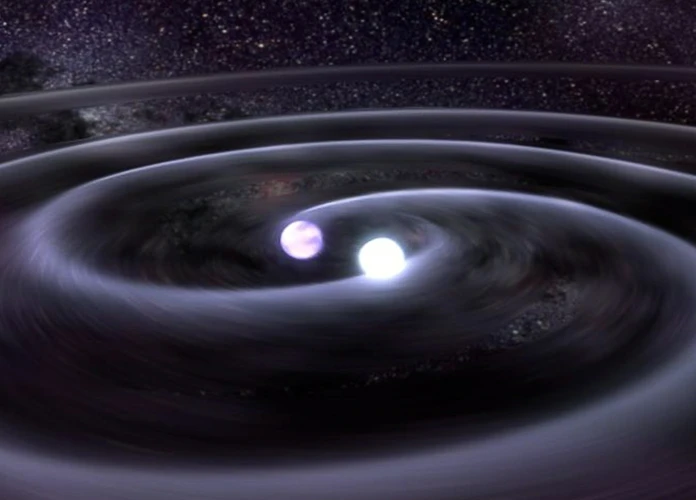Unveiling the Enigmatic Cosmic Duos: The Fascinating Dance of Binary Stars
Have you ever wondered what lies in the depths of our universe, beyond the solitary existence of stars? Enter the captivating realm of binary stars, a remarkable spectacle where two stars are locked in an eternal dance, bound by gravitational forces. In this enthralling cosmic duet, we explore the entangled lives of these binary systems, delving into their formation, dynamics, evolution, and intriguing phenomena. Prepare to embark on a journey through the mysterious world of binary stars as we uncover the secrets and complexities that lie within these enigmatic celestial partnerships.
What are Binary Stars?
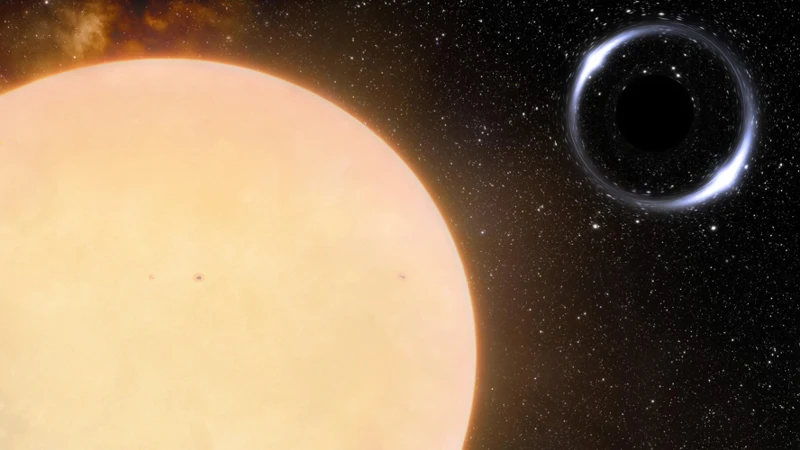
Binary stars, also known as stellar binaries, are a mesmerizing phenomenon that captivates the minds of astronomers and stargazers alike. These celestial partners are composed of two stars that are gravitationally bound to each other, engaging in an intricate and enthralling dance across the cosmic stage. Binary stars come in various forms, from tight-knit pairs where the stars orbit each other closely, to more widely separated systems where the stars have a significant distance between them. These captivating duos hold the key to unlocking a plethora of astronomical secrets, offering insights into stellar evolution, stellar interactions, exoplanetary habitability, and even the search for gravitational waves. So, let us delve into the enigmatic world of binary stars and embark on a fascinating journey through the cosmos.
1. Definition and Formation
Binary stars are defined as a celestial phenomenon where two stars are gravitationally bound to each other and orbit around a common center of mass. This captivating cosmic dance begins with the formation of binary systems, which can occur through various mechanisms. One common formation process is fragmentation, where a single parent molecular cloud collapses and breaks apart into multiple smaller fragments. Each fragment then gives rise to a separate star, resulting in a binary system. Another formation mechanism involves the capture of a passing star by a pre-existing star. In this scenario, the gravitational pull between the two stars causes them to become bound together in a binary orbit. Additionally, certain binary systems may have a more complex origin, such as hierarchical triple systems where three stars are involved. These intricate formations and diverse mechanisms contribute to the fascinating and dynamic nature of binary stars, providing astronomers with valuable insights into the intricacies of stellar evolution and the cosmic tapestry of our universe. To learn more about other intriguing cosmic phenomena, check out our article on dark matter and its enigmatic role in shaping the cosmos.
2. Types of Binary Systems
- Detached Binary: In this type of binary system, the two stars are relatively far apart, and their individual evolutionary paths are largely unaffected by each other. They orbit around a common center of mass, with their distances from each other remaining relatively constant over time.
- Semidetached Binary: Here, one star fills its Roche lobe, a region around a star where its gravitational influence dominates over the other star. This causes matter to flow from the donor star to the accretor star, forming an accretion disk. An example of a semidetached system is a binary star with a white dwarf accretor, known as a cataclysmic variable.
- Contact Binary: In a contact binary, the two stars are in such close proximity that they share a common envelope of gas, giving the appearance of a single distorted star when observed from a distance. Contact binaries are typically low-mass stars and can exhibit rapid rotation.
- Eclipsing Binary: This type of binary system occurs when the orbital plane of the stars is aligned in such a way that they periodically pass in front of each other from our line of sight. This results in a regular decrease in brightness, known as an eclipse. Eclipsing binaries provide valuable information about the sizes, masses, and temperatures of the stars involved.
- Spectroscopic Binary: Spectroscopic binaries are systems where the orbital motion of the stars is detected through shifts in their spectral lines. These shifts indicate that the stars are moving towards or away from observers on Earth. Spectroscopic binaries are often too far apart to exhibit eclipses, but their orbital characteristics can still be determined through careful analysis of their spectra.
From detached binaries that maintain their individuality to delicate contact binaries and captivating eclipsing and spectroscopic binaries, the varied types of binary systems offer a wealth of opportunities for astronomers to study the mysteries of stellar evolution and dynamics. Each type provides unique insights into the nature of these celestial duos and fosters our understanding of the fascinating dance of binary stars.
Dynamics of Binary Stars
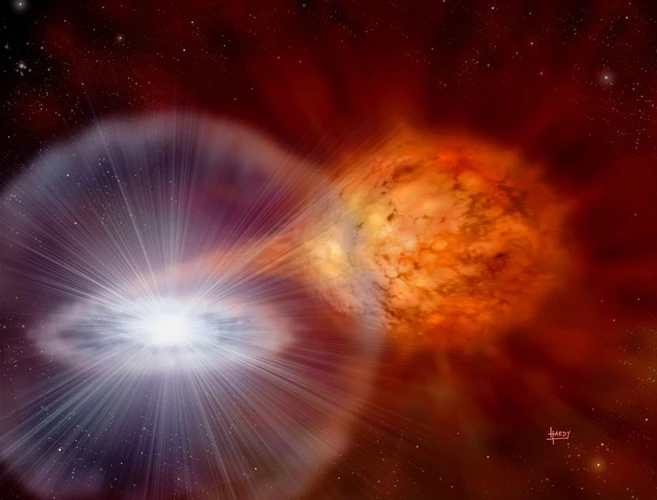
The dynamics of binary stars offer a captivating window into the intricate interplay between gravity and stellar motion. These cosmic duos exhibit a diverse range of behaviors and characteristics, shaping their orbits and interstellar relationships. Binary stars can be categorized into different types based on their mass ratios and orbital patterns. In some systems, the stars orbit each other in a regular, elliptical path, while in others, they may exhibit more complex and erratic motions. One type of binary system is the eclipsing binary, where the stars periodically pass in front of each other from our vantage point, causing variations in their observed brightness. Another type is the spectroscopic binary, where the presence of doppler shifts in the spectra of the stars indicates their mutual orbital motion. The study of binary star dynamics provides valuable insights into the processes of stellar formation, evolution, and even the search for dark matter in the universe. It is through unraveling the enigmatic dance of binary stars that astronomers continue to expand our understanding of the cosmos and the forces that drive it.
1. Orbits and Mass Ratios
Orbits and mass ratios play a crucial role in understanding the dynamics of binary stars. The orbit of a binary system describes the path traced by the two stars as they revolve around their common center of mass. These orbits can take various shapes, such as circular, elliptical, or even highly eccentric. The shape of the orbit is determined by factors such as the initial conditions of the system and the gravitational forces at play.
The mass ratio of a binary system refers to the ratio of the masses of the two stars. It provides insights into the relative sizes and masses of the stars involved. In some binary systems, the mass ratio is close to 1, indicating that the two stars have similar masses. These systems are known as equal-mass binaries. On the other hand, there are systems where the mass ratio is significantly different, with one star being much more massive than the other. These systems are referred to as unequal-mass binaries.
The study of orbits and mass ratios in binary stars allows astronomers to determine fundamental properties of the stars, such as their masses and distances. By observing the changes in the orbital motion of the stars over time, scientists can calculate the masses of the individual stars using Kepler’s laws of motion. This information is crucial for understanding stellar evolution and the dynamics of binary systems.
The mass ratio of a binary system can have implications for various astrophysical phenomena. In some cases, a highly unequal mass ratio can lead to tidal interactions between the stars, causing one star to transfer mass onto its companion. This phenomenon, known as mass transfer, can give rise to accretion disks, where matter accumulates around the more massive star. These accretion disks can lead to the formation of stellar jets and outbursts of X-ray emission.
Understanding the intricate dance of orbits and mass ratios in binary stars provides a wealth of information about the formation, evolution, and ultimate fate of these cosmic duos. By unraveling the mysteries of binary star systems, astronomers gain valuable insights into the workings of the universe and our place within it.
2. Eclipsing and Spectroscopic Binaries
Eclipsing and spectroscopic binaries are two distinct types of binary systems that provide invaluable insights into the dynamics and characteristics of binary stars. In an eclipsing binary, the two stars orbit each other in such a way that, from our vantage point on Earth, one star periodically passes in front of the other, causing a decrease in overall brightness. This phenomenon is known as an eclipse and allows astronomers to study the binary system’s properties, such as the size and mass of the stars, based on the duration and depth of the eclipses. Notable examples of eclipsing binaries include the Algol system and the famous eclipsing binary system known as Betelgeuse, which experience unusual brightness variations. On the other hand, spectroscopic binaries are systems where the presence of two stars is detected through variations in their spectral lines. By carefully analyzing the Doppler shifts in the spectral lines, astronomers can determine the orbital velocities, mass ratios, and other essential properties of the stars. These binary systems offer a tantalizing glimpse into the intricate motions and interactions of binary stars, shedding light on the complexities of stellar evolution and the dynamic nature of the universe.
Binary Star Evolution
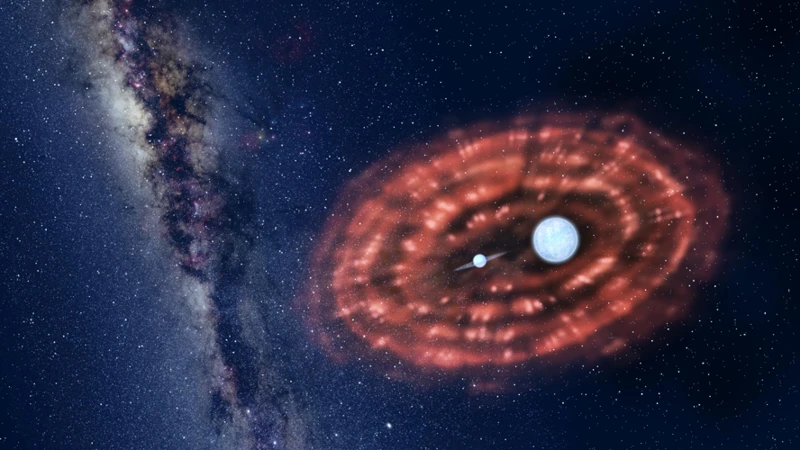
The evolution of binary stars is a captivating cosmic saga that unfolds over millions, and sometimes billions, of years. As these celestial duos progress through their journey, they experience a variety of stellar interactions and embark on common evolutionary paths. Binary star evolution is influenced by factors such as mass transfer, where material from one star is transferred to its companion, and the formation of accretion disks, swirling discs of gas and dust. These interactions can lead to the merging of stars, resulting in cataclysmic events such as supernovae. The fate of binary stars is intricately intertwined, with their mutual gravitational forces shaping their evolution and the potential for the birth of exotic objects like neutron stars and black holes. By unraveling the complexities of binary star evolution, astronomers can gain deeper insights into the life cycles of stars, shedding light on the enigmatic nature of our vast universe.
1. Stellar Interactions
Stellar interactions in binary star systems hold a profound influence on the evolution and behavior of these cosmic companions. When two stars are in close proximity, their gravitational forces can induce a range of interactions that shape their destinies. One such interaction is mass transfer, where material from one star is siphoned onto its companion. This process occurs when a star expands or becomes a giant, causing its outer layers to overflow onto its partner. The receiving star then experiences an increase in mass and may undergo significant changes in its structure and luminosity. Additionally, stellar interactions can lead to the formation of accretion disks, swirling discs of gas and dust that surround one or both stars. These disks have the potential to give birth to new stars or even exoplanets. Intense gravitational interactions between binary stars could result in stellar collisions or mergers, producing cataclysmic events such as supernovae. These explosive phenomena release an immense amount of energy and can have a notable impact on neighboring celestial objects and the surrounding space. The study of stellar interactions within binary star systems offers a captivating glimpse into the intricate dynamics and transformative processes occurring within the vast cosmic tapestry.
2. Common Evolutionary Paths
Binary stars take a variety of evolutionary paths throughout their lifespan, shaped by their initial conditions, stellar masses, and the interplay of gravitational forces. One common evolutionary path for binary stars is the phenomenon known as mass transfer. In this scenario, one star swells in size, forming a red giant, while its companion star, usually smaller, continues its regular evolution. The outer layers of the bloated star can extend beyond the Roche lobe, the gravitational boundary that defines the region where material is gravitationally bound to the star. As a result, the expanded star begins to transfer mass onto its companion, triggering a cascade of events. The transferred material can accrete onto the companion, causing it to gain mass and potentially alter its characteristics. This mass transfer process can profoundly impact the evolution of both stars, leading to changes in their size, temperature, and even triggering phenomena such as novae or supernovae explosions. Another common evolutionary path is the merger of binary stars. As the stars orbit each other, the loss of energy through gravitational wave radiation can gradually bring them closer together. Eventually, the two stars may merge, forming a single, more massive star. This merging process can have various outcomes, depending on the composition and mass of the stars involved. It can lead to the formation of rapidly rotating or pulsating stars, or even result in the birth of exotic objects such as blue stragglers or Thorne-Żytkow objects. Understanding these common evolutionary paths is essential in unraveling the intricate nature of binary stars and the remarkable phenomena they exhibit throughout their lifetime.
Binary Stars and Exoplanets
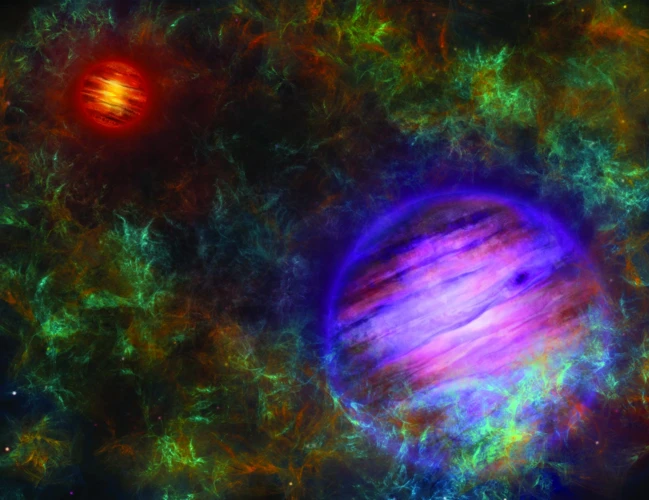
Binary stars and exoplanets, two celestial wonders intertwining in the vastness of space, offer a captivating glimpse into the possibilities of distant worlds. These cosmic duos hold a profound influence on the existence and potential habitability of exoplanets within their gravitational dance. Exoplanetary habitability, the conditions necessary for life to thrive, depends on a delicate balance shaped by the gravitational interactions and orbital dynamics within binary star systems. In some cases, binary stars may provide stable environments and even enhance the chances of habitability, as the gravitational pull of the stars can create stable regions known as habitable zones where liquid water may exist. Exploring the realms of binary stars and exoplanets unravels the intricate tapestry of our universe, shedding light on the possibilities of life beyond our own solar system.
1. Exoplanetary Habitability
Exoplanetary habitability is a topic of great interest and significance in the study of binary stars. The presence of binary systems can have profound effects on the potential habitability of planets orbiting these stellar duos. The gravitational interactions between binary stars can influence the stability of planetary orbits, leading to a wide range of conditions that could impact the habitability of any resident exoplanets. One key factor is the distance between the binary stars, known as the binary separation. If the separation is too close, gravitational forces from the stars may disrupt the planet’s orbit and result in extreme temperature fluctuations, intense radiation, and heightened tidal forces. On the other hand, if the separation is too wide, the planet might not receive sufficient energy and warmth to sustain life. However, there lies a sweet spot, known as the habitable zone or “Goldilocks zone,” where conditions could be just right for the existence of liquid water and potentially life as we know it. In these cases, the gravitational forces of the binary stars can actually stabilize the planet’s orbit and create a more stable and habitable environment. Researchers are actively studying the dynamics of binary star systems and their potential impact on exoplanetary habitability to deepen our understanding of the conditions necessary for life to thrive beyond our solar system. Through this ongoing investigation, we hope to uncover more about the intricate interplay between binary stars and the planets that accompany them, shedding light on the possibilities of life in the cosmos.
2. Examples of Exoplanets in Binary Systems
When it comes to the realm of exoplanets, binary star systems offer a diverse and intriguing environment for the existence of these cosmic worlds. One fascinating example is the Kepler-16 system, located approximately 200 light-years away in the constellation Cygnus. Within this system, two stars, Kepler-16A and Kepler-16B, orbit each other while being circled by a gas giant exoplanet known as Kepler-16b. This exoplanet, often referred to as a “Tatooine-like” planet due to its resemblance to the fictional world from Star Wars, orbits both stars in a complex dance, experiencing contrasting periods of daylight and darkness.
Moving on to the Kepler-34 and Kepler-35 systems, we encounter the first known binary star systems with multiple exoplanets. Kepler-34b and Kepler-35b are gas giant exoplanets that orbit their respective binary stars. These exoplanets are comparable in size to the largest planet in our solar system, Jupiter. Additionally, in the Kepler-47 system, we find yet another intriguing example of an exoplanetary system in a binary star setup. Kepler-47c, a Neptune-sized exoplanet, orbits its two host stars, Kepler-47A and Kepler-47B. This unique arrangement challenges our understanding of planetary formation and raises questions about the habitability of these worlds.
Indeed, these remarkable examples of exoplanets within binary star systems showcase the diversity and complexity of the universe. They provide astronomers with invaluable insights into the formation and dynamics of planetary systems in the presence of multiple stellar companions. As we continue to explore and study these extraordinary cosmic duos, we can expect even more fascinating discoveries that will reshape our understanding of the vast expanse of the cosmos.
Observing Binary Stars
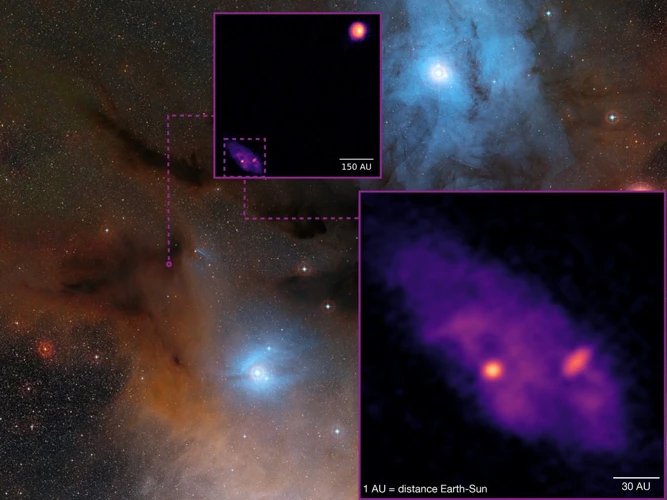
Observing binary stars is a captivating endeavor that allows astronomers to unravel the mysteries hidden within these celestial partnerships. To study and comprehend the intricacies of binary systems, scientists utilize a variety of observational techniques. One such method involves determining the apparent and absolute magnitudes of the stars, providing insights into their brightness and distance. Another powerful tool is spectroscopy, which allows scientists to analyze the spectral signatures of binary stars, revealing information about their chemical composition and temperature. Photometry is also employed to measure the changes in brightness as the stars orbit each other, shedding light on their orbital period and characteristics. Through careful observation and analysis, astronomers continue to deepen their understanding of binary stars, uncovering their secrets one observation at a time.
1. Apparent and Absolute Magnitudes
Apparent and absolute magnitudes play a crucial role in understanding the characteristics and properties of binary stars. The apparent magnitude refers to the brightness of a star when observed from Earth. It is influenced by factors such as the star’s distance from Earth and its intrinsic luminosity. On the other hand, the absolute magnitude measures the true brightness of a star from a standard distance of 10 parsecs. It provides a standard comparison for stars, irrespective of their distances.
To quantify and compare the apparent and absolute magnitudes of binary stars, astronomers use a logarithmic scale called the magnitude system. In this system, brighter stars have lower magnitudes, making negative values possible for exceptionally bright objects. For example, the Sun has an apparent magnitude of -26.7, while the brightest star in the night sky, Sirius, has an apparent magnitude of -1.46.
Through the calculation of the difference between the apparent and absolute magnitudes, astronomers can determine the distance to a star by utilizing the inverse-square law of light. This is known as the distance modulus equation. By measuring the apparent magnitude and knowing the absolute magnitude of a star, scientists can uncover its true distance from Earth.
Understanding the relationship between apparent and absolute magnitudes is vital in studying binary stars. By comparing the magnitudes of the two stars within a binary system, astronomers can gather valuable information about the stars’ characteristics, such as their relative sizes, temperatures, and distances from Earth. The apparent and absolute magnitudes provide essential data for analyzing the evolution and behavior of binary star systems, helping us unravel the fascinating mysteries of the cosmos.
2. Spectroscopy and Photometry
Spectroscopy and photometry are powerful techniques that astronomers employ to study and analyze binary stars. Spectroscopy allows scientists to dissect the light emitted by each star in a binary system, revealing valuable information about their composition, temperature, and movement. By separating the light into its constituent wavelengths, astronomers can detect spectral lines that provide clues about the elements present in the stars. These spectral lines can also help determine the velocity of each star and any orbital motion they undergo, offering insights into the dynamics of the binary system.
Photometry, on the other hand, involves measuring the brightness of the stars in a binary system at different wavelengths or over a specific period of time. This data allows astronomers to track variations in luminosity, which can indicate features such as eclipses, pulsations, or activity on the stellar surfaces. With photometry, scientists can create light curves, which are graphs that show how the brightness of each star changes over time. These light curves provide valuable information about the orbital period, mass ratios, and physical characteristics of the binary stars.
Combined, spectroscopy and photometry provide a comprehensive view of the binary stars, shedding light on their physical properties, orbital characteristics, and even the presence of any circumstellar material such as accretion disks. By studying the intricate interplay between these two stars, astronomers can unravel the fascinating mysteries and dynamics of binary systems, contributing to our understanding of stellar evolution and the broader complexities of the universe.
Mysterious Phenomena in Binary Systems

In the enigmatic realm of binary systems, a myriad of mysterious phenomena awaits our exploration. Among these captivating occurrences is the phenomenon of mass transfer and accretion disks. In certain binary systems, one star can siphon off material from its companion, creating a swirling disk of gas and dust around itself. This material then spirals inward, accreting onto the star and releasing immense amounts of energy in the process. These accretion disks give rise to intense X-ray emissions and can even lead to the formation of powerful jets of gas. Another intriguing phenomenon is the possibility of stellar mergers and supernovae. In some binary systems, stars may collide or merge due to their close proximity, resulting in catastrophic explosions known as supernovae. These cataclysmic events release an incredible amount of energy, leaving behind remnants such as neutron stars or black holes. The study of these mysterious phenomena in binary systems provides valuable insights into the complex and dynamic nature of our universe.
1. Mass Transfer and Accretion Disks
In the intricate dance of binary stars, one fascinating phenomenon that takes place is the process of mass transfer. This occurs when one star begins to transfer its mass to its partner star. This transfer can happen through various mechanisms, such as stellar winds or gravitational interactions. As the mass is transferred, it forms what is known as an accretion disk around the receiving star. An accretion disk is a swirling disk of gas, dust, and debris that forms as the mass from the donor star spirals towards the companion star. The material within the disk orbits the receiving star, gradually falling onto its surface. This process of mass transfer and the formation of accretion disks plays a crucial role in the evolution of binary stars, as it can significantly affect their dynamics and lead to the creation of unique phenomena, such as X-ray emissions and the formation of jets and outflows. By studying the intricacies of mass transfer and accretion disks in binary systems, scientists gain valuable insights into the complex nature of stellar interactions and the mechanisms that drive the evolution of these enigmatic cosmic duos.
2. Stellar Mergers and Supernovae
Stellar mergers and supernovae are extraordinary phenomena that occur within binary star systems, bringing forth remarkable cosmic events and transformations. When two stars in a binary system merge, a process known as a stellar merger, they undergo a catastrophic event where their outer layers collide and mix together. This collision releases an immense amount of energy, causing the merged star to temporarily become brighter and more massive. The aftermath of a stellar merger can lead to the formation of a new, rejuvenated star with unique characteristics.
On the other hand, the fate of some binary stars takes a more explosive turn. In certain cases, when one of the stars in a binary system reaches the end of its life, it undergoes a cataclysmic event known as a supernova. This occurs when a massive star exhausts its nuclear fuel and experiences a sudden and violent collapse. The immense gravitational pressure triggers a powerful explosion that blasts off the outer layers of the star into space, leaving behind a dense stellar core, such as a neutron star or a black hole.
The occurrence of stellar mergers and supernovae in binary systems plays a crucial role in shaping the universe. These events release vast amounts of energy, spewing out heavy elements and enriching the interstellar medium. They contribute to the formation of new stars, planetary systems, and even provide the building blocks for life. By studying these cosmic phenomena, astronomers gain valuable insights into the evolution and dynamics of binary stars, as well as the origin of the diverse structures and phenomena observed throughout the cosmos.
The study of stellar mergers and supernovae in binary systems also helps astronomers understand the mechanisms behind gamma-ray bursts and gravitational waves. These cataclysmic events can produce powerful bursts of high-energy gamma-ray radiation and gravitational waves, which are ripples in the fabric of spacetime. The detection and analysis of these signals provide valuable information about the extreme physics involved in these events and offer a window into the mysteries of the universe.
The occurrence of stellar mergers and supernovae in binary star systems is a captivating field of research that unravels the intricate nature of cosmic transformations. These events not only shape the evolution of stars but also have a profound impact on the universe as a whole. Through extensive observations, simulations, and analysis, astronomers continue to delve into the complexities of these phenomena, expanding our knowledge of the enigmatic dance of binary stars and the cosmic wonders they create.
The Search for Gravitational Waves
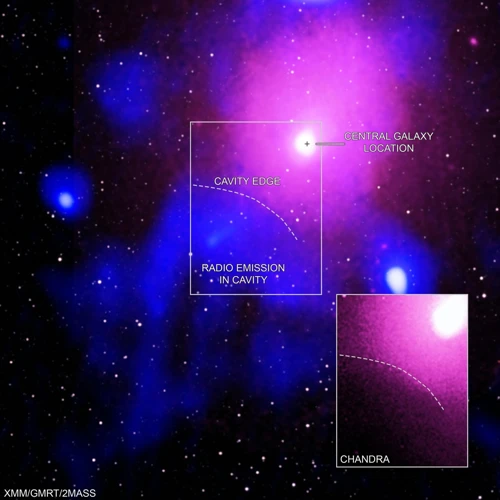
The search for gravitational waves has revolutionized our understanding of the universe and opened up a new frontier in astrophysics. These elusive ripples in the fabric of spacetime were predicted by Albert Einstein’s general theory of relativity in 1915. However, it wasn’t until 2015 that their existence was confirmed with the groundbreaking detection of gravitational waves from the inspiraling merger of two black holes. Since then, a multitude of gravitational wave events have been observed, including those originating from inspiraling binary neutron stars. These awe-inspiring discoveries have not only provided direct evidence of Einstein’s theory, but they have also offered unprecedented insights into the properties of extreme cosmic phenomena. The ongoing search for gravitational waves promises to unveil even more cosmic mysteries and transform our understanding of the universe, forever changing the way we perceive the fabric of reality.
1. Inspiraling Binary Neutron Stars
In the depths of our universe, an extraordinary celestial spectacle unfolds when two neutron stars become locked in a gravitational embrace, paving the way for an exhilarating cosmic dance. These binary neutron star systems are characterized by their incredibly dense, collapsed cores – remnants of massive stars that have undergone supernova explosions. As these neutron stars orbit each other, they gradually lose energy through the emission of gravitational waves, causing their orbits to slowly decay. This phenomenon, known as inspiral, leads to a breathtaking climax as the binary system spirals closer and closer together.
The inspiraling process is accompanied by an escalating release of gravitational waves, ripples in the fabric of spacetime predicted by Einstein’s theory of general relativity. These waves carry away energy from the system, resulting in a tighter and faster orbit. With each passing orbit, the gravitational waves become more intense, creating an ever-increasing gravitational wave frequency.
As the neutron stars approach their final moments, the gravitational forces between them become overwhelmingly strong. The intense gravitational interaction causes the stars to deform, stretching and squeezing their shapes. This tidal effect, known as tidal disruption, imparts unique gravitational signatures that can be detected and studied through advanced astronomical instruments.
The ultimate fate of inspiraling binary neutron stars is cataclysmic. As the stars come into close proximity, their mutual gravitational attraction becomes insurmountable. This leads to a dramatic event known as a neutron star merger, where the two stars collide and merge into a single, highly energetic entity. Such mergers unleash an incredible burst of energy in the form of a kilonova, producing a spectacular display of light across the electromagnetic spectrum.
The study of inspiraling binary neutron stars opens a window into the understanding of extreme physics, including the behavior of matter under extreme densities and gravitational fields. These cataclysmic events also contribute to the production of heavy elements, supplying the universe with elements such as gold, platinum, and uranium.
By detecting and analyzing the gravitational waves emitted during the inspiral and merger of binary neutron stars, scientists can probe the fundamental properties of gravity, test the limits of our current theories, and gain insights into the origins of the universe itself. This frontier of astrophysics holds immense potential for unraveling the mysteries of our cosmos and expanding our knowledge of the enigmatic dance of binary stars.
2. Discoveries and Implications
The study of binary stars has led to numerous remarkable discoveries that have revolutionized our understanding of the universe and posed intriguing implications for various fields of research. One significant discovery is the detection of gravitational waves emitted by inspiraling binary neutron stars. These waves, predicted by Einstein’s theory of general relativity, were first observed in 2017 by the Laser Interferometer Gravitational-Wave Observatory (LIGO) and Virgo collaborations. The detection of gravitational waves from binary neutron star mergers not only confirmed a major prediction of Albert Einstein’s theory, but also opened up an entirely new field of astronomy known as gravitational wave astronomy.
The implications of these discoveries are profound. Gravitational wave observations provide a unique window into the violent and cataclysmic events that take place in the universe, such as the mergers of compact objects like neutron stars and black holes. They allow scientists to directly measure the properties of these objects and study extreme physics in ways that were previously inaccessible. The detection of gravitational waves from binary neutron star mergers has shed light on the origins of heavy elements in the universe. These mergers are believed to be responsible for the production of elements like gold and platinum, providing valuable insights into the cosmic origins of these precious materials.
The discoveries associated with binary stars and gravitational waves have also paved the way for exciting future prospects. The development of more advanced gravitational wave detectors, such as the planned upgrades to LIGO and the construction of the Einstein Telescope, promises to unlock even greater insights into the mysteries of the cosmos. The ongoing research in this field holds the potential to not only deepen our understanding of the fundamental laws of the universe but also inspire new technologies and innovations that can benefit society as a whole. The study of binary stars and the detection of gravitational waves have truly opened up a new era of exploration, offering glimpses into the hidden workings of the universe and pushing the boundaries of human knowledge.
The Future of Binary Star Research
The study of binary stars has come a long way, but there is still much to discover and unravel. As technology and observational capabilities continue to advance, the future of binary star research holds tremendous promise. Here are some exciting developments on the horizon:
1. Advancements in Instrumentation: With the advent of innovative telescopes and instruments, astronomers will gain access to higher resolution images, finer spectroscopic measurements, and improved sensitivity. This will enable them to study binary stars with greater precision, unraveling their intricate dynamics and unraveling mysteries that have eluded us thus far.
2. Multi-Wavelength Observations: By observing binary systems across a wide range of wavelengths, from radio waves to X-rays, scientists can obtain a more comprehensive understanding of these cosmic duos. This multi-wavelength approach will provide insights into various aspects, including the presence of accretion disks, stellar winds, and magnetic fields, ultimately enhancing our knowledge of binary star evolution.
3. The Role of Citizen Science: Citizen science initiatives have gained popularity in recent years, allowing amateur enthusiasts to contribute to scientific research. With the help of citizen scientists, large datasets of binary star observations can be accumulated and analyzed, expanding the reach of binary star research and uncovering new insights.
4. Continued Exoplanet Exploration: The study of exoplanets in binary systems will remain a focus of future research. Astronomers will continue to investigate the habitability of these planets and explore the dynamics of their orbits in binary star environments. Additionally, advancements in technology may enable the detection of smaller, Earth-like exoplanets within binary systems.
5. Gravitational Wave Astronomy: The field of gravitational wave astronomy continues to evolve, and binary stars play a crucial role in this domain. Ongoing advancements in gravitational wave detectors will allow scientists to observe and study inspiraling binary neutron star systems, providing valuable insights into their formation, mergers, and the nature of matter under extreme conditions.
The future of binary star research holds immense potential for groundbreaking discoveries, shedding light on the intricacies of stellar evolution, exoplanetary systems, and the fundamental nature of our universe. As scientists continue to explore the cosmic duet of binary stars, we can expect a wealth of new knowledge and profound insights into the enigmatic dance of these celestial partners.
Conclusion
In conclusion, the dance of binary stars provides a captivating window into the mysteries of the universe. These cosmic duos offer profound insights into stellar formation, dynamics, and evolution. They hold the potential to reveal valuable information about exoplanetary habitability and the existence of unique phenomena such as accretion disks and stellar mergers. Furthermore, binary systems play a vital role in the ongoing search for gravitational waves, opening up new avenues for astrophysical discoveries. As we continue to unravel the enigma of binary stars, we venture closer to understanding the intricate mechanisms at work in the vast expanse of our cosmos. The future of binary star research holds great promise, with advancements in technology and observational techniques allowing us to explore these celestial partnerships like never before. From revealing the secrets of our universe’s evolution to uncovering the mysteries of dark matter and the behavior of neutron stars, binary stars are a crucial component in the tapestry of cosmic exploration. So let us gaze upwards and marvel at the fascinating dance of binary stars, forever reminding us of the intricate and wondrous nature of our universe.
Frequently Asked Questions
1. What is the primary characteristic of binary stars?
Binary stars are characterized by their gravitational connection, where two stars orbit around a common center of mass.
2. How do binary stars form?
Binary stars can form through several processes, including fragmentation of a collapsing molecular cloud, capture of a passing star, or division of a single star due to tidal forces.
3. What are the different types of binary systems?
Binary systems can be classified into three main types: visual binaries, spectroscopic binaries, and eclipsing binaries, each revealing distinct properties and behaviors.
4. How do astronomers determine the mass ratio of binary stars?
Astronomers determine the mass ratio of binary stars by analyzing their light curves, radial velocity measurements, and spectroscopic observations.
5. What are eclipsing binaries?
Eclipsing binaries are binary star systems in which the orbital plane is aligned with Earth’s line of sight, causing regular and periodic eclipses as one star passes in front of the other.
6. Can binary stars influence the habitability of exoplanets?
Yes, the presence of binary stars in a system can have a significant impact on the habitability of exoplanets, affecting factors such as temperature, radiation levels, and stability of planetary orbits.
7. Are there any known exoplanets in binary systems?
Indeed, there have been numerous exoplanets discovered in binary star systems, such as the Kepler-16, Kepler-34, and Kepler-35 systems, showcasing the diversity of planetary environments.
8. How do astronomers measure the brightness of binary stars?
Astronomers measure the brightness of binary stars using two different methods: apparent magnitude, which is the brightness as seen from Earth, and absolute magnitude, which represents the intrinsic brightness of a star.
9. What are accretion disks in binary systems?
Accretion disks are formed in binary star systems when one star transfers matter onto its companion, resulting in the formation of a swirling disk of gas and dust around the receiving star.
10. Can binary stars merge or result in supernovae?
Binary stars have the potential to merge or lead to supernovae if the stars come close enough to initiate mass transfer or if one star exhausts its nuclear fuel, leading to a dramatic cosmic explosion.

